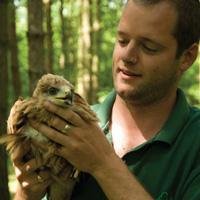
The Forestry Commission is a government department, making it a public sector organisation. Its mission is ‘to protect and expand Britain’s forests and woodlands and increase their value to society and the environment ‘.
It is Britain’s largest land manager and is responsible for some of the UK’s most spectacular landscapes. Over the last 20 years it has expanded Britain’s woods by an area more than three times the size of Greater London.
However, that is not the whole story. The Commission’s 3,000 staff also:
- manage forestry land owned by the government, including 15,000 miles of roads and 2,300 bridges
- support and regulate the use of privately-owned forests and woodlands
- plant and renew forests
- restore landscapes
- develop open forestry spaces to provide forest walks, concert venues, bike trails and even wind farm sites
- help to protect Britain’s trees from pests and diseases
- contribute to wealth generation by providing jobs and selling products. For every £1,000 raised from timber and forestry, another £3,000 is generated to the UK economy from associated products and services, for example, tourism, paper and food
- represent the UK at international forest-related talks and negotiations.
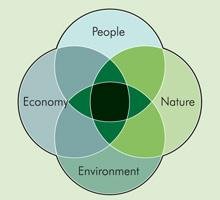
The Forestry Commission has always placed operating in a ‘green’ manner top of its agenda. It balances four related needs: people, nature, environment, economy.
The Forestry Commission takes a long-term view about how it can help create a better environment for everyone in this country. For example, forests:
- if sustainably managed, provide many benefits. The Forestry Commission ensures its forests are sustainably managed and encourages private owners to do so too
- provide extremely low carbon sources of energy and fuel
- provide the lowest energy consuming and carbon-emitting building materials available
- help to absorb carbon emissions from other industrial activities
- provide a micro-climate for many species of insects and animals for example, oak trees support more than 600 species of plants and animals
- provide recreational outdoor spaces that contribute to healthy lifestyles. Over 50 million visitors each year to Forestry Commission sites generate more than £2 billion in revenue
- create employment within the forestry and other industries, such as construction, tourism and engineering.
The case study will show how training and development is central to the work of the Forestry Commission and how it benefits the career development of its people.
It will particularly highlight the work of Julie McMorran, a civil engineer with the Forestry Commission, for whom training and development has provided the springboard to promotion.
Roles within the organisation
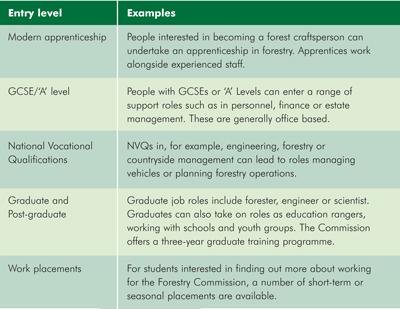
A job role is made up of the tasks and responsibilities a person takes on at work. The Forestry Commission needs a wide range of skills and abilities to fulfil its variety of roles. People can join at different entry levels. There are different levels of responsibility within the organisation.
Murray Livingstone recently started a two-year apprenticeship with the Forestry Commission. Murray works in the West Argyll Forest District as a forest craftsperson, harvesting trees for timber. His initial training involved learning about different types of machines and health and safety on the forest site. This is a first line job which one day could go on to a middle management post as a senior Forester.
Julie McMorran is a civil engineer. Some of her projects involve building new roads and bridges for timber lorries to get in and out of forestry areas. Alternatively, she might create concepts, and design and test models for footbridges, walkways or towers. These form part of the Forestry Commission’s recreational work for walkers, cyclists or even theatre events.
At a higher level within the organisation, Gordon Donaldson is a Forest District Manager. His work includes managing the restoration of forest land at Loch Katrine in Scotland. This involves removing non-native plants and re-establishing farming of highland cattle in the area.
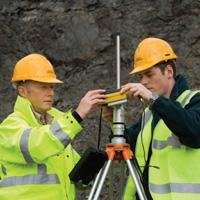
All employees working with the Forestry Commission receive good rates of pay, which can rise steadily with greater responsibility. For example, a Senior Project Engineer is currently paid up to £41,000 per year. Other benefits include a company car.
The Forestry Commission promotes employees from within the organisation. Whether employees join with qualifications from school, college or from university, they have the opportunity of a long-term career path. The Forestry Commission benefits by keeping its trained staff, which is less costly than recruiting new ones.
The importance of training

Training provides the opportunity to gain or improve relevant skills or knowledge.
The Forestry Commission invests heavily in a range of training essential for the organisation’s growth and development:
- health and safety training, for example, in the safe use of equipment and pesticides. Regular refresher training is required under health and safety laws
- technical skills, such as how to handle and work safely with powerful machines
- other skills such as communication and leadership. These are required, for example, by employees in both logging areas and tourism roles
- customer care skills necessary for working with the public, other organisations and internal customers.

The Forestry Commission has a culture of Continuous Professional Development (CPD). This is supported by a system of regular appraisals. An appraisal involves employees reviewing performance with their line managers to identify areas where they want or need to learn more. They then develop a training plan to fill the gaps. Part of the appraisal involves setting SMART objectives so the trainee knows what to expect.
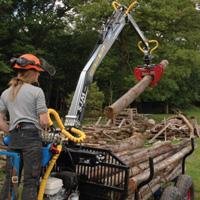
The Forestry Commission is proud of its status as an Investor in People (IiP). This award is given to organisations that show a high commitment to looking after the needs of all their people. It sees training as an investment that helps the organisation to meet its aims and objectives.
Training allows staff like Julie McMorran to engage in learning that has clear links to their current or future roles. Julie wants to take more responsibility for her work so she is now studying for a Masters Degree in timber engineering.
Training can motivate employees and help them to work their way up through the organisation. They can develop their skills and knowledge to allow them to take their next career step. Becoming office manager might be the next step for an administrative support worker. A forest craft worker might move up to become a works supervisor.
Types of learning and training
On-the-job
‘On-the-job’ training involves training at work. This is the best way of learning practical work based skills. The trainee learns by carrying out real work tasks under instruction from a colleague, trainer or manager. For foresters this includes how to plant new seedlings and protect them from the cold and heat. Methods include:
- coaching – the coach guides and instructs the trainee
- mentoring – a mentor, a more experienced person, provides advice and support
- secondment – an employee goes to work elsewhere for a short period to learn useful skills.
An apprentice will combine work with a more experienced forester who will help and guide them, with formal studying for a qualification. On-the-job training is cost-effective.
Off-the-job
‘Off-the-job’ training involves attending courses and training events away from the workplace, for example, Julie’s university degree. Benefits include the opportunity of meeting other people in similar roles and discussing new ideas.
The Forestry Commission invests heavily in training for managerial development. This provides the leaders of the future. Through the appraisal process all employees have a Personal Development Plan (PDP) which highlights their strengths and weaknesses. This makes it possible to build on the strengths and improve areas of weakness through training and development.
The Forestry Commission’s Leadership Programme helps a manager learn to take on more responsibility. This may be through:
- 360 degree feedback – managers are given feedback on their way of working from above (by their line manager), from below (by those working for them), from the side (by peer workers)
- specialist courses at development centres
- formal study or distance learning, like Julie’s Masters Degree.

The Forestry Commission has created a Competency Framework of the skills required by the organisation and its employees. The diagram shows how this would work for a mechanical engineer.
Identifying individuals’ skills gaps makes it possible to design appropriate training for them. This might include taking a higher degree or updating Health and Safety training.
Training in action
A good way of looking at how training works at the Forestry Commission is to examine the training opportunities provided for Julie McMorran. The profile highlights how the training she has received has developed her career.
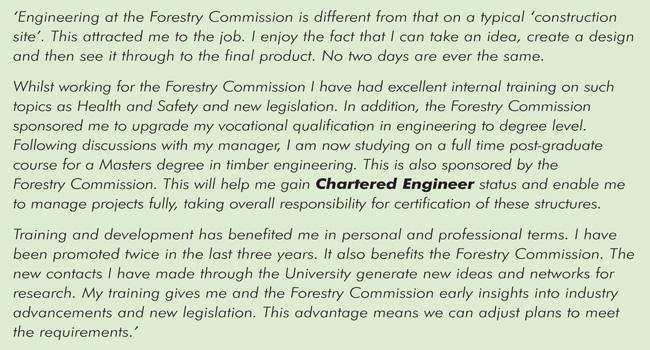
Conclusion
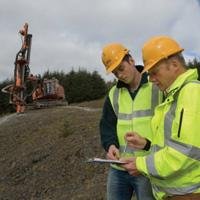
People who work for the Forestry Commission perform a wide variety of jobs. They are all important in contributing to the overall aims and objectives of the organisation.
To carry out their roles effectively they need training. Development helps them to grow as individuals and take on extra responsibility, which adds value to the organisation.
The Forestry Commission’s investment in training and development enables employees like Murray Livingstone, Gordon Donaldson and Julie McMorran to develop more confidence in their roles. It also allows them to become more equipped to achieve their own and the organisation’s objectives. The result is a better managed ‘green’ forest resource that everyone can benefit from people, animals, plant life, and our planet.
